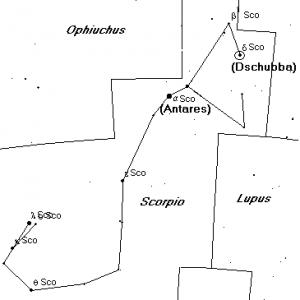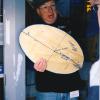Delta Scorpii Erupts
Delta Scorpii, the fourth brightest star in the constellation Scorpius has intensified from magnitude 2.3 to 1.9. The star is now so bright that folks familiar with the sky find the Scorpion very much changed.Delta Scorpii (also called Dschubba pronounced desh - shoe - bah) is the tip of the left claw. Dschubba means "forehead" because ancient Arab astronomers saw this entire area as the head rather than as claws.Delta Scorpii is very similar in size and spectral type to Gamma Cassiopeia which erupted in 1937. If Delta Scorpii continues to follow the Gamma Cassiopeia pattern, it will brighten further to magnitude 1.7 for a couple of years. Then it should dim to magnitude 3.1 for about 15 years. 20 to 25 years from now it will return back to its original magnitude (2.3).Delta Scorpii is about 590 light years away, near as stars go. The eruption has changed the nature of the light from Delta Scorpii. Stars have an "atmosphere" called a corona that is hovers above an "ocean" called the photosphere. The photosphere normally is the major source of light. The corona tends to absorb a bit of the photosphere's light causing dark lines in the spectrum (kind of a rainbow) of colors emitted by the star. Delta Scorpii is currently so excited that the corona is shines brightly. The dark bands have become bright emission bands.Delta Scorpii will become a major object of interest at Frosty Drew Observatory while it is high enough to see. Come to the Observatory and we'll show you this new luminary. We will conduct sessions where we try to estimate its brightness by comparing it to other stars of known brightness. This will be an ideal target for binoculars.Venus, Neptune and Uranus are in the sky most of the night during August. If you stay late enough, you'll also get the first glimpses of Saturn and Jupiter this year. These giants are finally up before we head home. Mars is still only visible early in the morning. Mercury will make an appearance towards the end of the month and on through September in the western sky. It is great to have the planets back after a long hiatus when they were on the other side of the Sun.Comet Linear has dropped into the southern skies and is racing away into the sunless void between the stars. It passed the Sun at the end of July and will rapidly fade as it moves out several times as far as the Earth is from the Sun. We may actually lose sight of it very quickly because it seems to have broken apart as it rounded the Sun. It never reached unaided eye brightness in Rhode Island (although it did in some mountainous states). However it was an easy target with even the most modest binoculars.
- Author:
- Leslie Coleman
- Entry Date:
- Aug 1, 2000
- Published Under:
- Leslie Coleman's Columns


